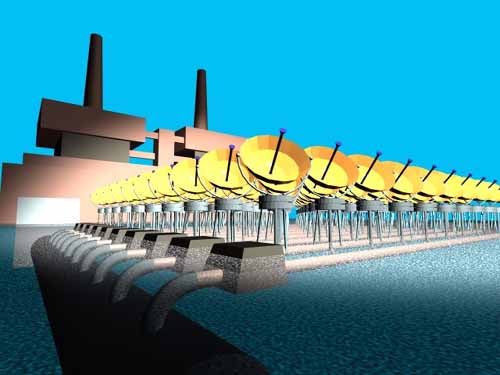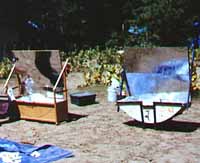|
WHAT IS SOLAR COMBUSTION AIR?
It is a method of preheating
air to a natural gas burner, like a hot water heater. But more importantly
it can preheat air to a coal burning power plant, or any typical fossil
fuel burner, such as a propane, or oil stove. Preheating of air is
actually a very common practice in industry. For example, often air is
preheated by molten metal from a blast furnace. The preheated air is then
blown into the firebox and mixed with fuel. The net result is less fuel is
burned. It is kind of like preheating air to a wood stove. The net result
is not as much firewood is burned, thus you don't have to chop as much
wood. The only difference is that solar energy is utilized by this
patented process to preheat air, thus replacing the need to burn as much
fuel.
WHAT IS THE MARKET POTENTIAL FOR SOLAR COMBUSTION AIR?
It is
huge. It is a little known fact, but the amount of energy falling from the
sun unto parking lot paving alone will power the entire United States.
Parking lot surfaces do get hot, especially in places like Phoenix. This
energy can be usefully used to reduce natural gas consumption for perhaps
hot water heaters or absorption cycle air conditioning. OIL AND GAS
JOURNAL estimates state that within the next two decades close to 30
TRILLION DOLLARS (U.S.) will be spent world wide on energy
development. The vast majority of it will be spent on development of
energy from combustion of fuels such as oil or gas or coal, and a little
wood. This patented invention is a hybrid system, a combination of both
fossil fuel and solar produced air. Thus, is less expensive than entirely
solar operation, or coal-only, or oil/gas only operation. Many places in
the world such as North Africa, Mexico, Australia, and the American West
have extensive solar energy. Even in the Pacific Northwest, there are
sunny periods. In fact, Wind Energy and HydroPower as from rainfall, can
be integrated with Solar Combustion Air. Thus, when the sun is cloudy,
wind and hydropower can also manufacture hot air. It is a little known
fact, but often the amount of sunlight falling upon a coal strip mine will
power the entire coal burning power plant. Thus the idea is to construct
these "solar parking lot pavements" on top of coal strip mines using
recycled materials and local labor. This would be done as part of the land
reclamation process. In short, it is estimated that the total cash flow
over the lifetime of the patent would be over 10 trillion dollars
worldwide, with adequate investment and R&D. Unlike other technologies
like cold fusion, almost anyone with basic physics and economics can
understand how it works.
HOW DOES THE INVENTION WORK?
Simple to understand. Solar
collectors concentrate sunlight to a tiny spot which is very hot (often
above 750 degrees F, but can be several thousand). The concentrated
sunlight then manufactures hot air, which is (important) then compressed
by photovoltaics or any type of blower or fan. The now compressed and
heated hot air is then blown beneath a special pavement, not unlike a
typical parking lot. Underneath the parking lot is a network of pipes
(made of recycled materials). These pipes then transport the hot and
compressed air to the firebox of a residential hot water heater, or better
yet to the firebox of a coal burning power plant. The air is very hot in
the range of 300 to several thousand degrees depending on application. The
air is also compressed, and can be up to that of a typical water pipe
(typically up to 50 PSI or three atmospheres). The air also travels very
fast, up to the speed of sound (50 to 500 miles per hour). It is important
to note that the friction of the air on the pipe also translates to heat.
Because the pipes are below ground and insulated they trap the heat. Thus
the pipes can preheat air at night or even in the middle of winter. Thus
Solar Combustion Air can be used by the power plant 24 hours out of the
day, year round. In effect, heat is stored underground like a battery, and
then used when it is cold or at night. There are two designs. One design
is for urban parking lots, where cars park around solar collectors. The
second design is for rural application like coal stripmines in New Mexico
or Arizona, which do not have cars parking on them. Because air is
utilized instead of more expensive heat transfer fluids, the cost of heat
transfer is minimal. If for example, a leak was to result from a heat
transfer piping system, it would result in a loss of million of dollars of
heat transfer oil. Furthermore, hot air requires less expensive piping
than for heat transfer fluids. Steam piping would be prohibitively
expensive, but if hot air should leak....who cares!
WHAT ARE THE ECONOMICS AND PROFIT POTENTIAL?
This is the only
invention that cuts emissions of pollution and Carbon Dioxide (Greenhouse
Gases) in half. For a coal burning power plant this means that air
pollution equipment does not have to be so big, or work so hard.
Furthermore, it means that fuel bills are cut in half. This is easier on
the environment in that not as much coal strip mining is necessary, or as
much drilling for oil/gas required. It also means that the power plant can
operate longer since there is less maintenance. Solar Combustion Air is
very clean and less corrosive. To power a large power plant, like the size
of Four Corners in Fruitland, New Mexico, it will require about 24 square
miles of land area, and an extensive network of pipes. However, it
recycled materials are used, combined with modern manufacturing
engineering techniques, it is predicted that solar combustion air should
be directly competitive with oil or gas or coal, on a cost per BTU basis.
To date the best study on Solar Repowering of Power Plants has been done
by Charles Bensinger of Santa Fe New Mexico. His study, which did not
include Solar Combustion Air, reviewed related solar repowering
technologies. His conclusion, is that hybrid solar-coal, solar-oil,
solar-gas operation is 15 to 33% more expensive than oil-only, gas-only or
coal-only operation. However, the technologies reviewed are more expensive
than Solar Combustion Air. The conclusion drawn here is that with cost
reduction of solar technology, it would be a marketable alternative.
Eventually fossil fuels can be replaced with solar produced hydrogen,
creating a solar-hydrogen conversion. The plan is to gradually build up
the system. For example, the first year only a few square miles (for a
large power plant) would be built, thus only handling 10% of the heat
load. The next year, 20% of the heat load would be handled by solar, and
so on. Thus, the system is phased in. Of note, is as the system is added,
the new additions become immediately revenue producing. Thus, lending to
easier financing.
WHAT ARE THE IMPACTS UPON GAS AND ELECTRIC
UTILITIES?
Integration of solar technology really is in the
interest of utilities. For example, by installing Solar Combustion Air on
residential homes, it will help conserve natural gas. While conventional
wisdom would say the gas utilities are opposed to solar, in reality solar
integration helps "load level management". In effect, in the winter when
natural gas pressure is low, it helps to replace some natural gas with
solar. Thus, the line pressure remains high. The problem is not so much a
"geologic" shortage of natural gas, as it is more of a lack of "pipe
diameter" of pipe. You can only pipe so much gas through a pipeline at
once. By integrating solar collectors, and other conserving technology, it
helps natural gas utilities to maintain line pressure in even the coldest
of winters. It also allows new land developments to build a gas utility
for lower cost, since not as large of pipe diameter is required.
OTHER INFORMATION ABOUT SOLAR?
Additional information about
solar energy can be obtained by reviewing the web pages of:
SOLAR ENERGY INDUSTRY ASSOCIATION,
Washington DC
SOLAR ENERGY
ASSOCIATION, Boulder, Colorado
INTERNATIONAL SOLAR
COOKING ASSOCIATION, Sacramento, California
PHOTOS: 
The above power plant is located in Centralia Washington. One of the
rainest placest in the United States. A preliminary review for installing
Solar Combustion Air was done by staff at Seattle City Light and at the
power plant. Seattle City Light is a 8% owner. The conclusion: solar only
operation would be difficult but if wind energy and hydropower was also
integrated to make Solar Combustion Air it may be economically
feasible. 
The above computer 3-D simulation illustrates a possible view of what a
converted Solar Combustion Air power plant would look like. Shown here are
"dish type" solar collectors. However, other type of hot air solar
collectors are available, such as Trough Type, which are square and long,
and concentrating flatplates. Hot air is manufactured by the solar
collectors and then compressed and blown underground. The underground pipe
network feeds the power plant. Waste heat from the power plant can be used
to power for example a "freon-turbine" which in turn drives a big fan,
literally sucking the hot air from the solar collector field. Electric
power from the power plant can also be used to help blow the air. 
Illustrated above is the drawings used by U.S.Patent 5308187. Patented
by Inventor Martin Nix of Seattle Wa. 
Shown above is a special solar collector being engineering specifically
for solar combustion air. The key is to simplify and design to economics.
Many solar collectors are expensive, requiring large and expensive
tracking systems. This particular design is a simple system, designed to
be easily and quickly mass produced. A field of these can power a home or
a large power plant.
HOW DO WE CONTACT THE INVENTOR?
Write to: Martin Nix PO Box
95173 Seattle WA 98145-2173 or email to SOLARSH@ESKIMO.COM |




